Welcome to my delicious homemade Sweet and Sour Pork recipe that brings the authentic flavours of Chinese to your kitchen. This classic dish features crispy pork bites coated in a sweet and tangy sauce, creating a delightful combination of flavours that’s easy to prepare and perfect for a satisfying meal. This is truly a tasty and comforting Chinese favourite that tastes exactly like you get in your local Chinese restaurant, but better!
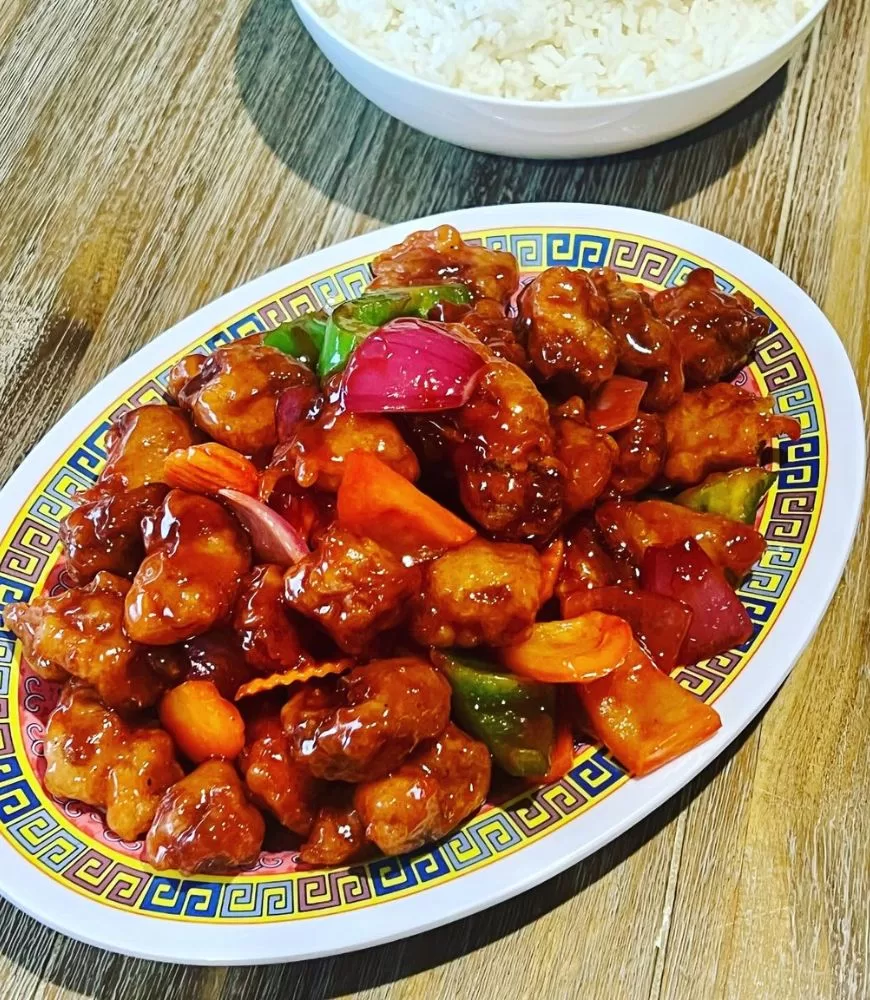
Sweet and Sour Pork is a popular Chinese dish that features bite-sized pieces of pork, typically battered and deep-fried until crispy. The dish is then coated in a flavourful sweet and sour sauce made from a combination of sugar, vinegar, ketchup, and the secret ingredient – a dash of Worcestershire sauce.
Additional ingredients such as capsicum, carrot, onions, and pineapple are included for added texture and taste. The result is a deliciously balanced combination of sweetness, tanginess, and savoury flavours, making it a favourite in Chinese cuisine both in restaurants and homemade kitchens.
This dish works equally well with chicken too! If using chicken, choose from thigh or breast. Due to the velveting of the meat, if using breast, it will be still be tender and juicy.
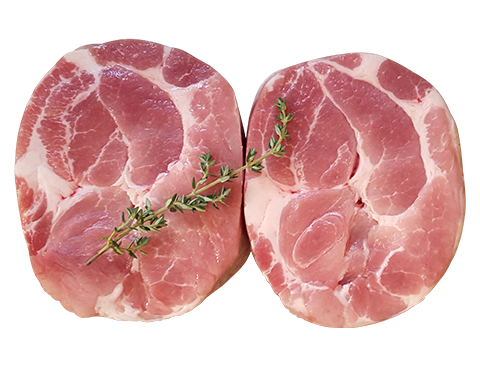
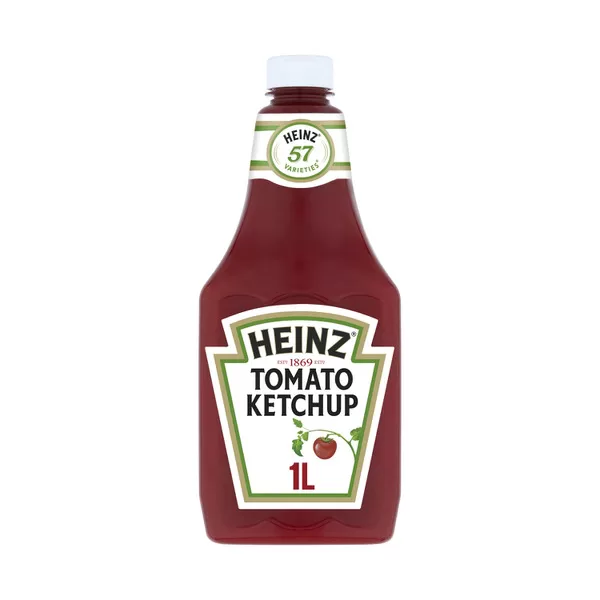
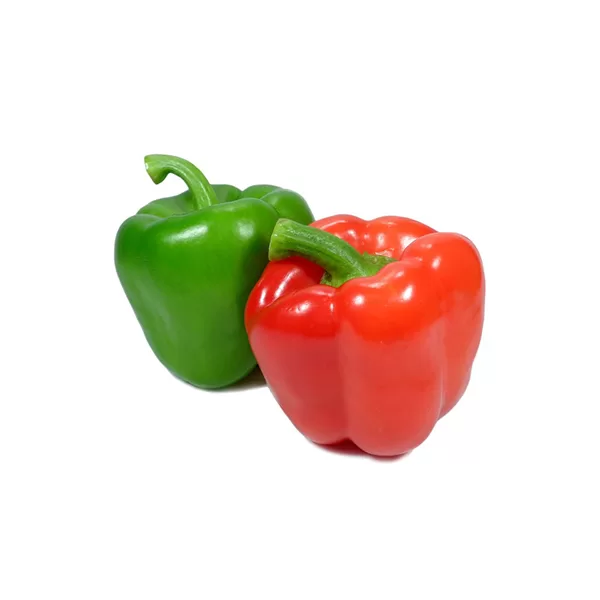

How to make
- Marinate Pork: Dice pork and mix with marinade ingredients. Refrigerate until needed.
- Make Batter for Pork: Create batter by whisking together flour and cornflour. Adjust with tap water for thickened cream consistency. Chill for a maximum of 1 hour.
- Prepare Sweet & Sour Sauce: Combine sauce ingredients in a bowl. Set aside.
- Chop Vegetables: Ensure veggies are uniformly chopped for even cooking.
- Deep Fry Pork in Batter: Heat oil to 180C. Coat pork in batter, then drop into hot oil in batches. Fry for 3 minutes or until golden. Drain on a wire rack. Repeat with remaining pork.
- Deep Fry Pork for Second Time: Reheat oil to 200C. Do a second fry on pork batches for 1 minute until golden brown and really crisp. Drain and set aside.
- Stir-fry Vegetable in Wok: Heat 1 tbsp veggie oil in a wok over medium-high heat. Stir-fry veggies (excluding pineapple) for 1-2 mins. Pour in sauce, bring to a boil, then turn off heat.
- Add Pork & Pineapple and Serve: Add fried pork and pineapple. Toss well to coat in sauce. Serve immediately and enjoy!
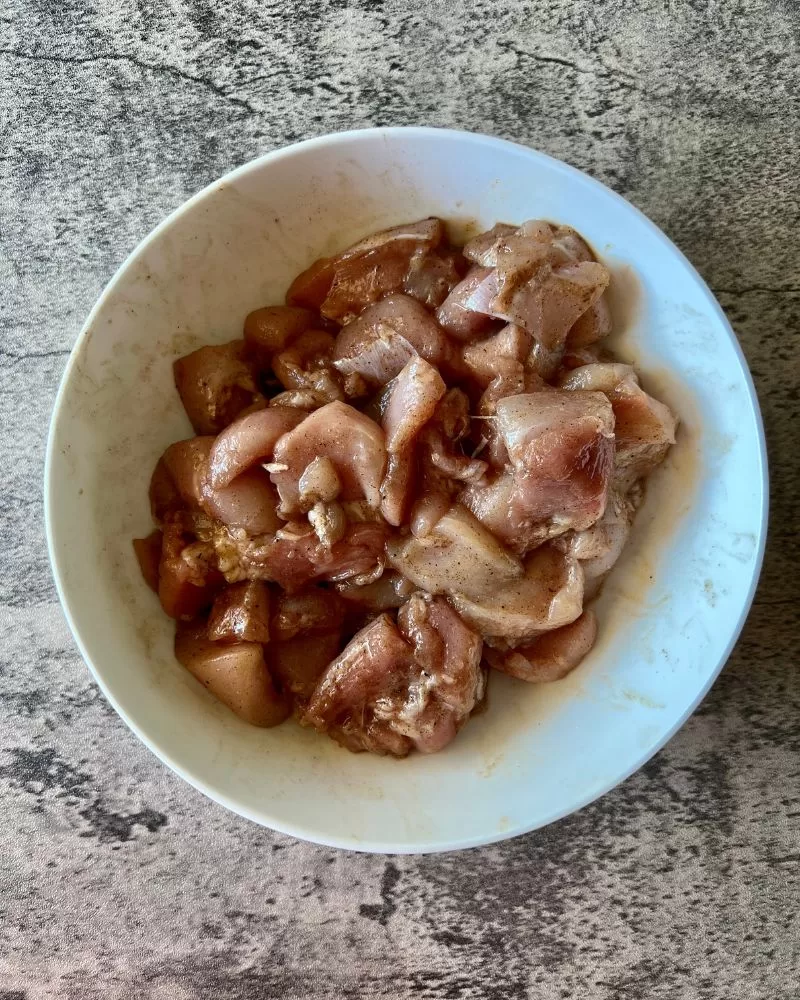
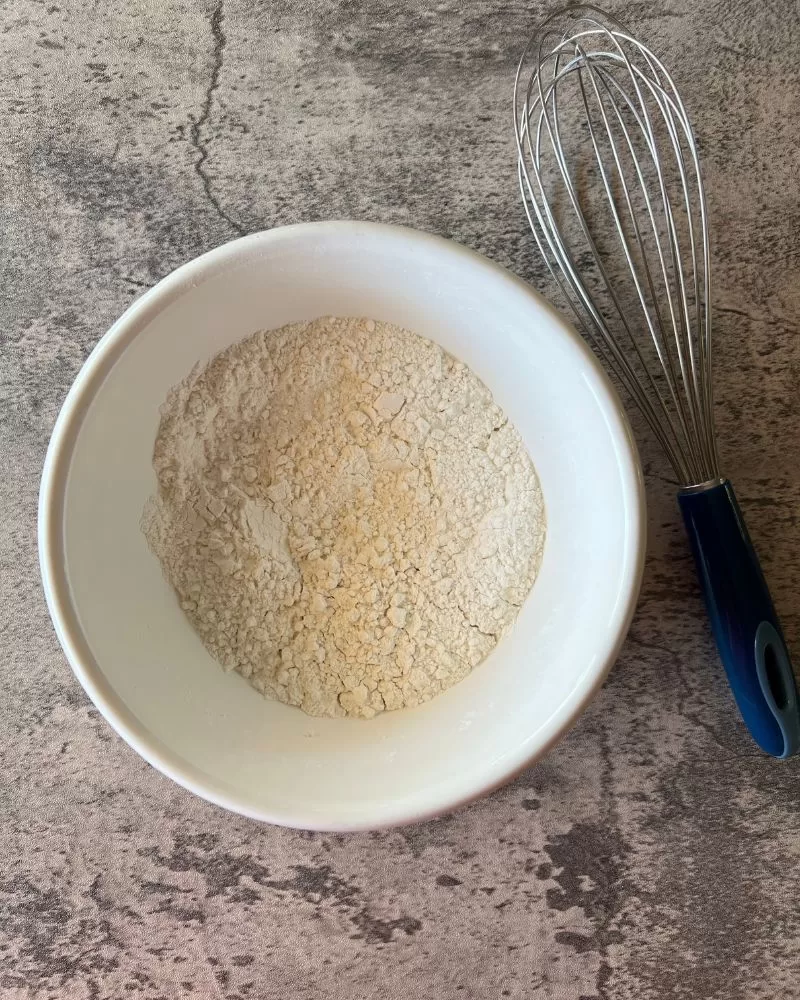
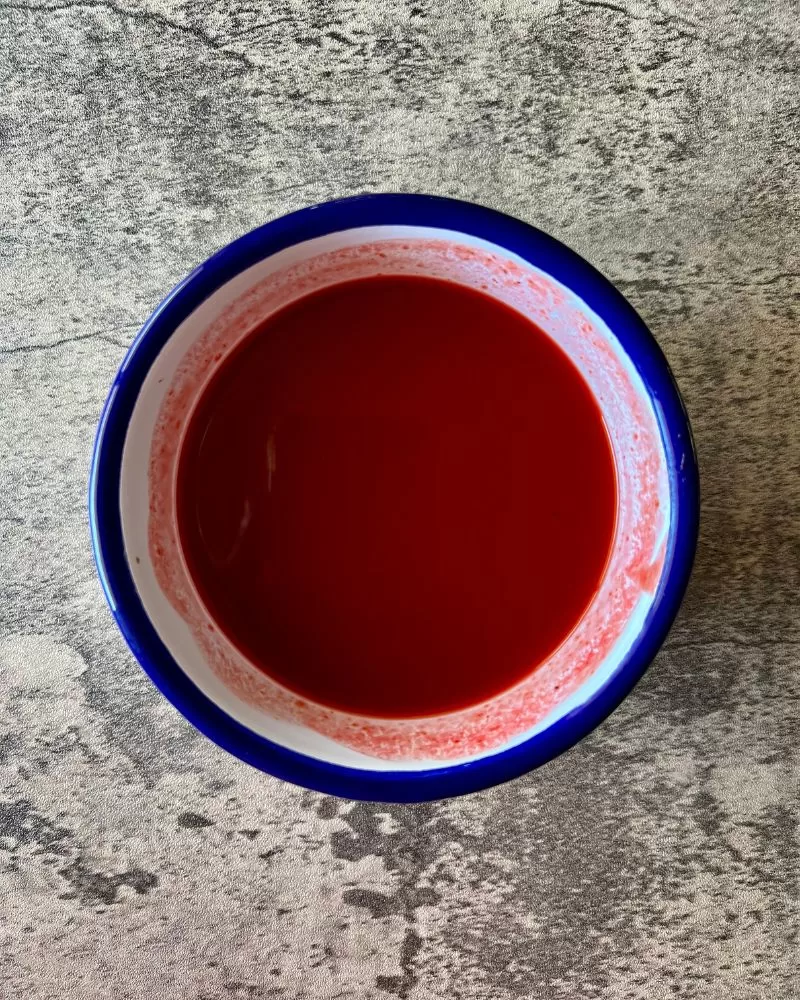
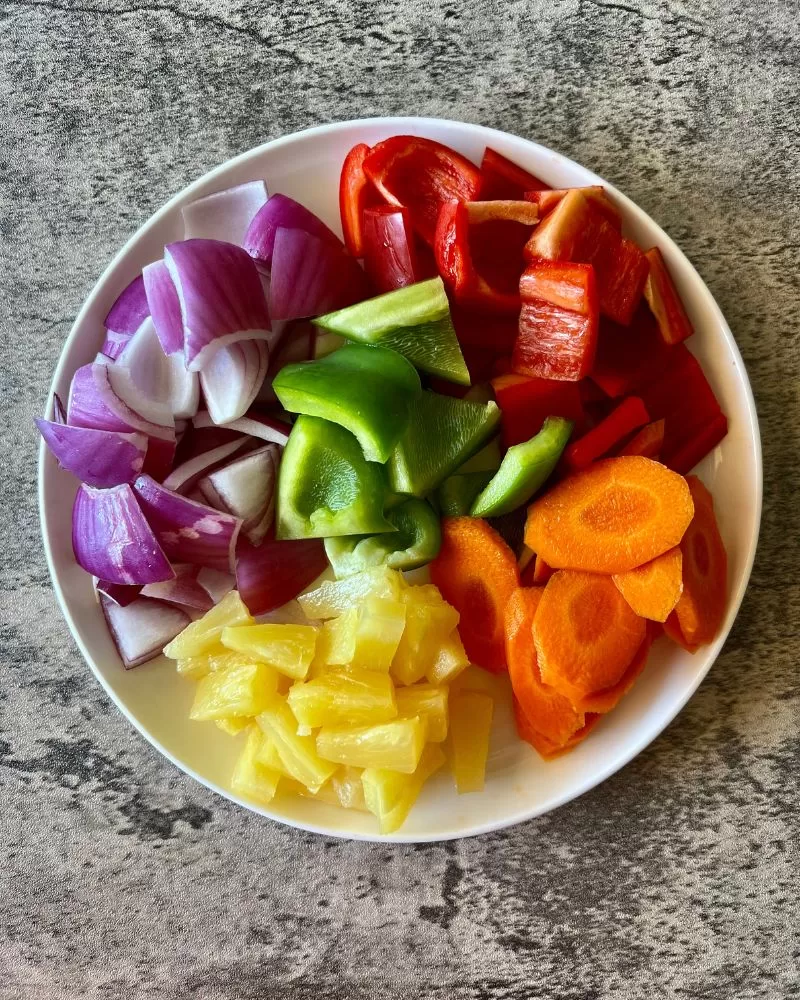
Why do a double fry?
Double deep frying is a cooking technique commonly used for certain meats, including items like chicken wings, french fries, and, in this case, sweet and sour pork. The process involves frying the food twice at different temperatures, and it serves several purposes:
- Crispiness: The primary reason for double frying is to achieve a crispier texture. The initial fry cooks the food through and begins the process of developing a crispy exterior. The second fry at a higher temperature helps to further dehydrate the surface, resulting in a more substantial and crunchy crust.
- Moisture Control: Double frying is effective in controlling the moisture content of the food. The first fry allows the interior to cook while retaining moisture. The second fry at a higher temperature then removes excess moisture from the surface, preventing the food from becoming soggy.
- Colour Development: The double frying process gives an appealing golden-brown colour on the exterior of the food.
- Oil Absorption: Frying at a lower temperature initially allows the food to absorb less oil, as the moisture inside creates a barrier. The second, higher-temperature fry then quickly seals the surface, minimising further oil absorption and resulting in a less greasy end product.
In the case of this sweet and sour pork, the double frying method is used to create a contrast between the crispy exterior and tender inside of the pork, allowing it to hold up well against the sweet and tangy sauce without becoming soggy.

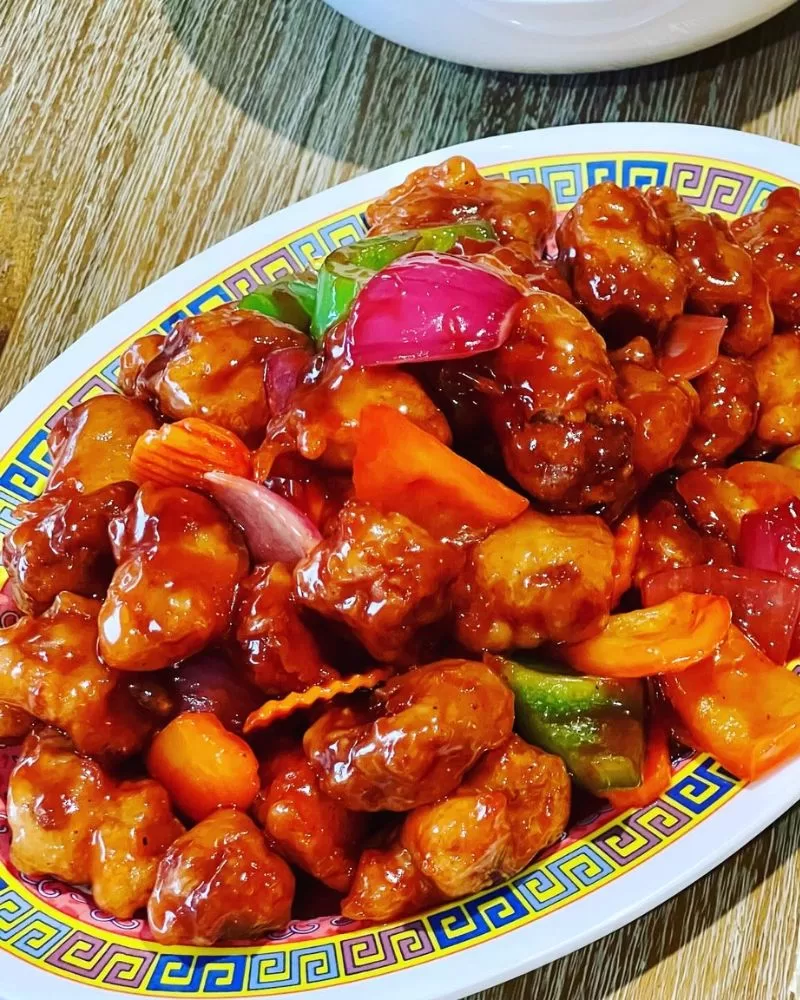
Serving suggestions
Sweet and Sour Pork pairs well with a variety of side dishes. Below are some serving suggestions for you:
- Steamed Rice: Serve the sweet and sour pork over a bed of steamed white or brown rice.
- Fried Rice: The pork pairs well with fried rice. The combination of textures and flavours adds an extra dimension to the meal.
- Noodles: Choose your favourite noodles, such as chow mein or hokkien, and toss them with the sweet and sour pork.
- Vegetables: Include a side of stir-fried or steamed vegetables like broccoli, sugar snap peas or Chinese greens. .
- Sesame Seeds or Spring Onions: Garnish with a sprinkle of sesame seeds or spring onion curls.
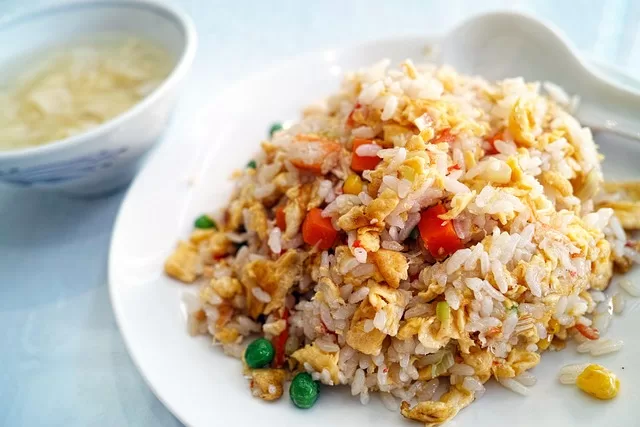
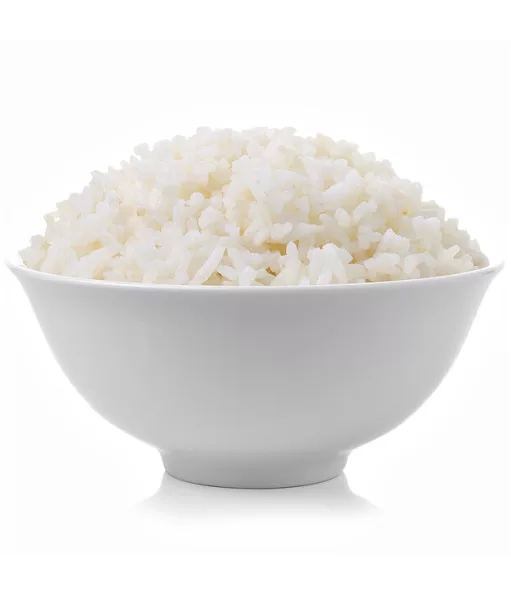
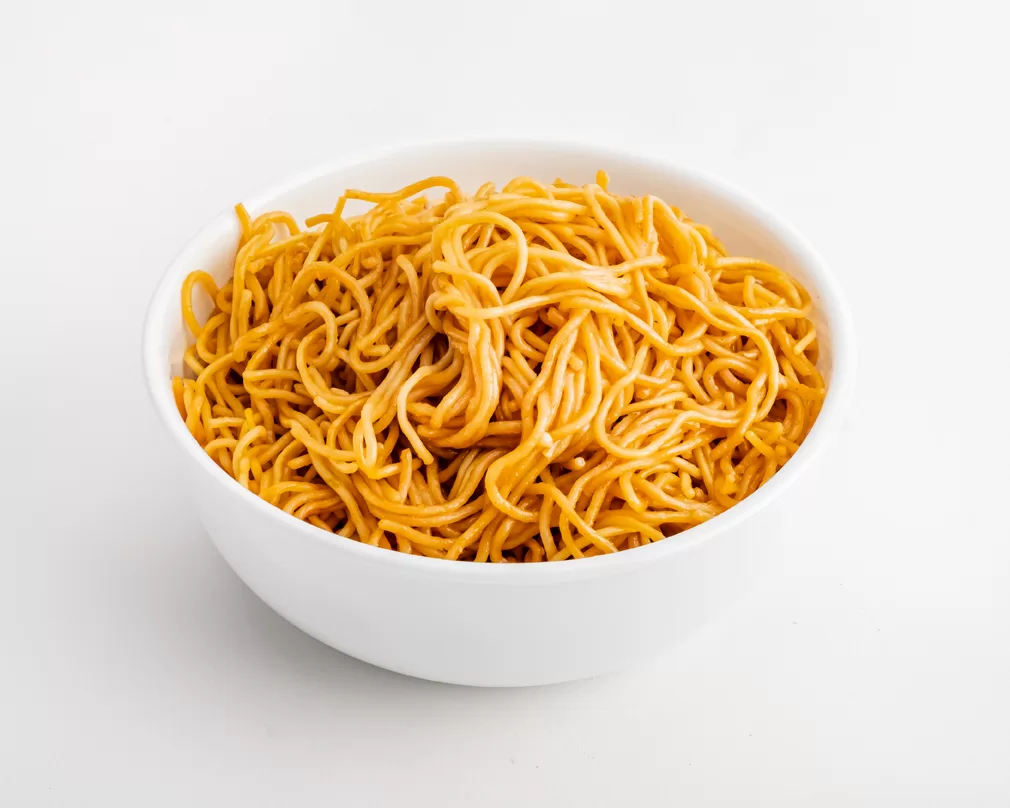
❄️ Storage
FRIDGE:
Allow to cool to room temperature before refrigerating. Cover with plastic wrap or transfer leftovers to an airtight container. Consume within 2-3 days.
FREEZE:
I do not recommend freezing.
TO REHEAT:
When ready to eat, reheat gently in the microwave (MEDIUM 50% power) until it piping hot and evenly heated.
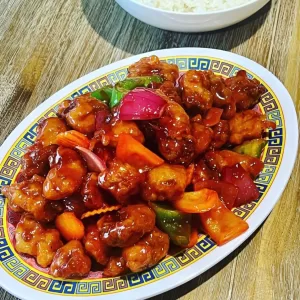
Sweet and Sour Pork (just like a restaurant)
Equipment
- Wok or large frying pan
- Electric deep fryer or large saucepan
Ingredients
MARINATED PORK
- 500g pork scotch fillet or pork belly, cut into small bite size pieces (See Notes)
- 1 teaspoon chicken stock powder (See Notes)
- ½ teaspoon Chinese 5 spice powder
- ¾ teaspoon bicarbonate soda
- ½ teapsoon ground white pepper
- pinch of salt
- ½ teaspoon MSG (optional – See Notes)
- ½ teaspoon sesame oil
- 2 teaspoons Shoaxing wine (Chinese cooking wine)
BATTER
- 1 cup self-raising flour
- ½ cup cornflour or potato starch
- Water
SWEET AND SOUR SAUCE
- ⅓ cup ketchup or tomato sauce
- ⅓ cup caster sugar (can use white or brown sugar)
- ¼ cup white vinegar
- 2 tablespoons pineapple juice (reserved from the can for the stir fry)
- 2 tablespoons water
- 2 teaspoons Worcestershire sauce
- 2 ½ teaspoons cornflour
- 1 teaspoon MSG (optional – See Notes)
- Few drops of red food colouring (optional)
STIR FRY
- ½ large red onion, cut into large chunks
- ½ small red capsicum, cut into chunks
- ½ small green capsicum, cut into chunks
- 1 small carrot, cut into 2-3mm thick slices
- 227g can pineapple chunks in juice, drained (reserve the juice for the Sweet & Sour Sauce)
Instructions
MARINATE PORK
- Combine pork with all marinade ingredients in a bowl. Cover and chill until required, or up to 24 hours ahead of time. If you only have 10 minutes thats fine too, while you get the rest of the dish prepped.
BATTER
- Create batter by whisking together flour and cornflour. Add enough cold tap water until you get the consistency of thickened cream. You can use immediately or chill for a maximum of 1 hour.
SWEET & SOUR SAUCE
- Whisk all ingredients in a bowl until throughly combined. Set aside until ready to use.
DEEP FRY (1ST)
- Heat enough oil in a wok or saucepan to come one-third up the side over medium high heat until it reaches 180C. (alternately use an electric deep fryer according to manufactures instructions) Coat pork in batter, then drop one-by-one into hot oil in batches. Fry for 3 minutes or until golden. Drain on a wire rack. Repeat with remaining pork. (TIP: I use food safe gloves here to help reduce with messy hands. I use a new glove for every batch)
DEEP FRY (2ND)
- Reheat oil to 200C. Do a second fry on pork, in batches, for 1 minute 30 seconds or until golden brown and really crisp. Drain and set aside.
STIR FRY
- Heat 1 tablespoon oil in a wok over high heat. Add the onion, capsicums and carrot and stir-fry for 1-2 minutes or until slightly softened. Pour in the prepared sweet and sour sauce and bring to boil. Once boiling, turn heat off and add all the fried pork and the pineapple pieces. Toss well to coat. Transfer to a serving platter or plates and serve immediately. Enjoy 🙂
Notes
- COOKS NOTES:
Oven Temps: Oven temperatures are for conventional, if using fan-forced (convection), reduce the temperature by 20˚C.
Measurements: We use Australian tablespoons and cups: 1 teaspoon = 5 ml, 1 tablespoon = 20 ml & 1 cup = 250 ml.
Herbs: All herbs are fresh (unless specified) and cups are lightly packed.
Vegetables: All vegetables are medium size and peeled, unless specified.
Eggs: We use extra-large size and eggs are 55-60 g each, unless specified. - PORK
The best cut of pork for making this dish is either pork scotch fillet (aka – pork neck) or pork belly, with the skin and any bones removed, for the best flavour and juiciest pork bites. The use of bicarb soda in the marinade is a Chinese tenderising secret also known as velveting which means the pork will remain juicy and the outside can get extra crisp.
Other pork cuts can be used such as tenderloin, pork loin steaks etc but because they are leaner, they will be more prone to drying out. The marinade will help counteract this though and if this is all you have, don’t not cook this dish. Use it, it will still be delicious.. - CHICKEN STOCK POWDER
I use a Chinese style chicken stock powder called Knorr Chicken Powder which can be found in Asian grocers and even some large Coles supermarkets. It is the best for Chinese cookinig but your regular chicken stock powder with brands such as Continental or Massel is perfectly fine to use as well. - MSG
MSG, or monosodium glutamate, is a flavour enhancer that is commonly used in Chinese cooking, as well as in various cuisines around the world. It is the sodium salt of glutamic acid, an amino acid that occurs naturally in many foods. Here are some reasons why MSG is used in Chinese cooking:- Enhanced Umami Flavour: MSG is known for its ability to enhance the savoury or umami taste in foods. Umami is one of the five basic tastes (along with sweet, salty, bitter, and sour), and it contributes to the overall depth and richness of a dish. MSG intensifies the natural flavours of ingredients, making the food more delicious and satisfying.
- Balancing Flavours: MSG can help balance and round out the flavours in a dish. It is often used in small quantities to enhance the taste of other ingredients without imparting a specific flavour of its own.
- Culinary Tradition: MSG has been used in Chinese cooking for decades and is considered a traditional seasoning in many Asian cuisines. It is often used in conjunction with other umami-rich ingredients like soy sauce and oyster sauce.
- PINEAPPLE
I like to use the canned pineapple chunks in juice (not in syrup). If desired, you can also use fresh pineapple. If using fresh, omit the pineapple juice from the sweet and sour sauce so you don’t need to source it. It will still taste great.
If using fresh though, add it to the wok at the same time as adding the vegetables rather than after to give it time to soften.
You may also enjoy
- Crispy Lemon Honey Chicken
- Chicken & Ham Spring Rolls
- Crispy Prawn Balls
- Pork & Prawn Wontons with Snow Peas
- Satay Chicken Curry
- Chinese Sweet & Sour Dipping Sauce (Just Like a Restaurant)






Leave a Reply